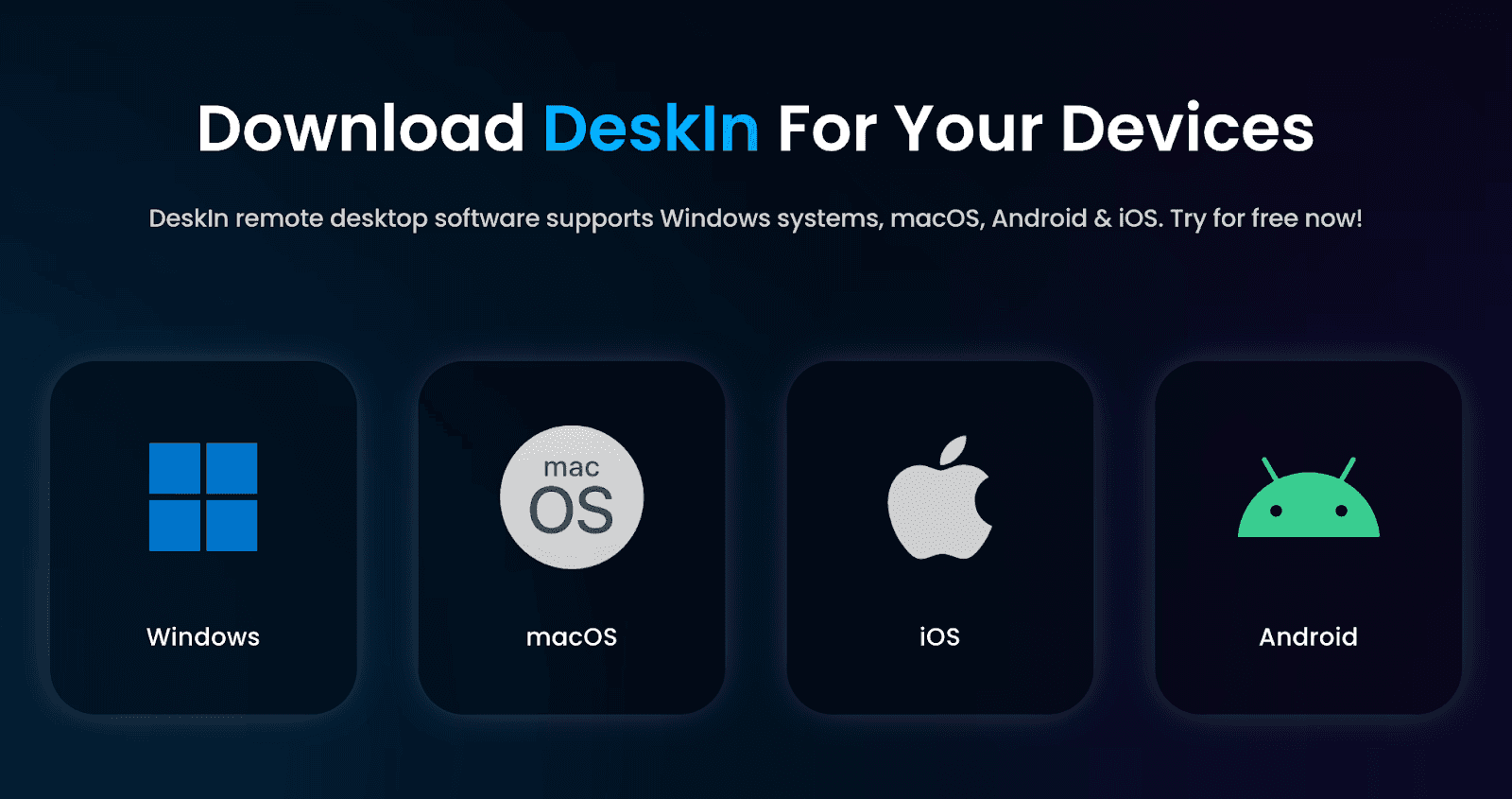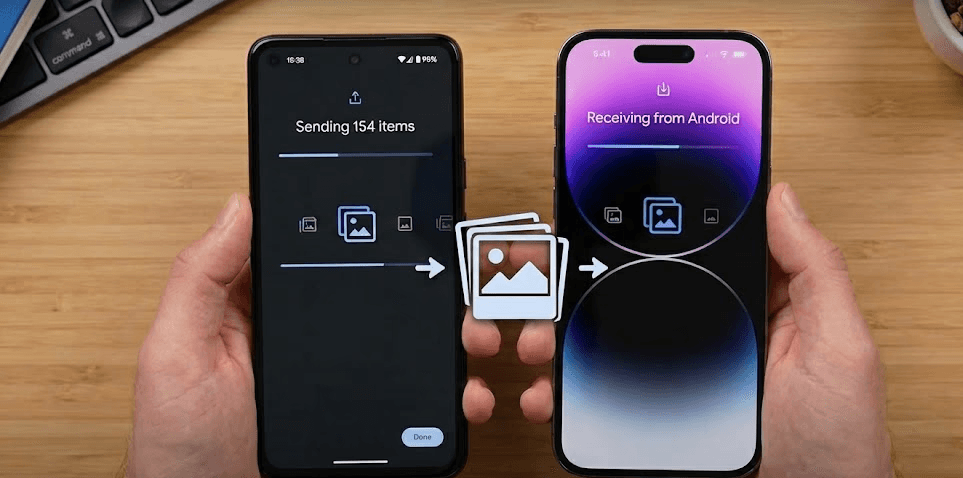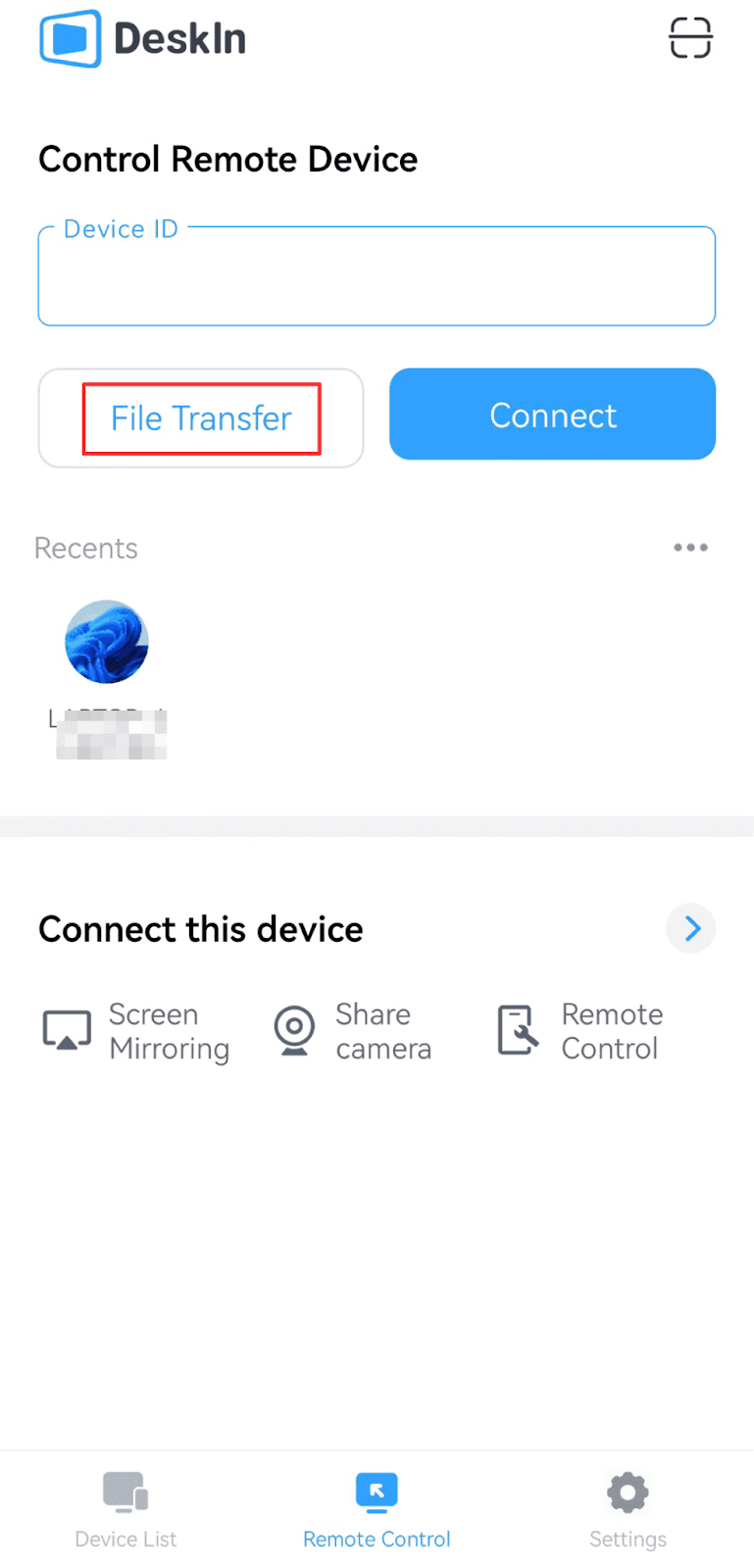Do you often get that dreaded iPhone warning — “Storage Almost Full”? You look at all those precious photos and memories piling up, wanting to back them up on your computer but don’t know where to start. Finding an efficient yet simple method to transfer photos from your iPhone is a common struggle for many users.
Don’t worry — this article puts together the most complete guide for both wired and wireless transfers. Whether you’re on Windows or Mac, you’ll find detailed steps below — from the fastest recommended tools to built-in system methods — to make photo backup effortless. Let’s dive in!
Read more:
Recommended Method: Transfer iPhone Photos to Computer with DeskIn (Unlimited & Fast)
DeskIn is a powerful cross-platform remote desktop tool that perfectly solves the issue of how to transfer photos from iPhone to computer. It allows wireless photo transfer between your iPhone and PC via a high-speed, stable connection. There are no limits on file size, type, or quantity, and it supports transfer speeds up to 12MB/s, letting you easily back up all your precious photos and videos.
Key Features:
Unlimited transfer: Send any number of photos or even large 4K videos without restrictions.
Cross-platform compatibility: Works seamlessly across Windows, macOS, and iOS.
High-speed transmission: Up to 12MB/s—faster than most remote desktop or cloud methods.
Rich remote features: Beyond file transfer, DeskIn supports screen extension (turn your iPad or phone into a second monitor), screen mirroring, voice calls, annotations, shared clipboard, and more—perfect for both personal and work use.
On Windows PC / On Mac
Step 1: Download & Install DeskIn
Install DeskIn on both your iPhone (via App Store) and Windows PC/Mac (via DeskIn’s official site). Then sign up using the same email and verify your account.
📥 Tip: DeskIn offers a free version with enterprise-level encryption for safe and secure use.

Step 2: Connect Your Devices
On your iPhone, open the DeskIn app and go to the Device List. Find your computer or manually enter its device code under Remote Control and tap File Transfer.

Step 3: Connect devices
Input the computer’s security or temporary password to establish a secure connection.
Step 4: Transfer Your Photos
Once connected, tap Send File → select the desired photos/videos → choose the target folder on your computer → then tap Send.

Step 5: View Files on Computer
The transferred files will appear in your chosen computer folder or under “Me” → “Downloaded Files” in DeskIn’s desktop app. You can also transfer files from your computer to your iPhone the same way.
Windows Users: 4 Ways to Transfer iPhone Photos to Your PC
Besides DeskIn, there are several traditional ways to transfer photos from iPhone to Windows. Below are four reliable methods — both wired and wireless — including their limitations and setup requirements.
1. Transfer via USB Cable (Windows 10/11)
The simplest method is to use a USB data cable. However, compatibility issues or photo format problems (like HEIC) might prevent your PC from reading images correctly.
Steps:
Use an original or MFi-certified Lightning cable to connect your iPhone to your PC.
Unlock your iPhone and tap Trust This Computer when prompted.
On your PC, open File Explorer → find your iPhone under “This PC.”
Open Internal Storage > DCIM, where your camera photos and videos are stored.
Copy and paste (Ctrl+C / Ctrl+V) the desired photos or folders into a target location on your PC.
Tip: If your PC can’t read HEIC files, go to Settings > Camera > Formats on iPhone and select Most Compatible, or install a HEIC extension on your PC.
Read more:
2. Use iCloud for Windows
The biggest advantage of iCloud is wireless synchronization—no cables required.
However, it depends on internet speed and only offers 5GB of free storage.
Steps:
Download iCloud for Windows from the Microsoft Store.
Sign in with your Apple ID (same as your iPhone).
Check Photos, click Options, and enable “iCloud Photos.”
On your iPhone, go to Settings > [Your Name] > iCloud > Photos and enable iCloud Photos.
On your PC, open File Explorer > iCloud Photos to view or download synced photos.
3. Use Microsoft Photos App
The built-in Photos app on Windows lets you easily import photos without extra software.
However, large transfers may be less stable.
Steps:
Connect your iPhone to your PC using a Lightning cable.
Open Photos on your computer (search “Photos” in Start Menu).
Click Import > From a USB device.
Select the desired photos and click Import Selected.
4. Use Cloud Services (Wireless Transfer)
Using cloud storage services like OneDrive, Dropbox, or Google Photos allows wireless transfer without cables, but you’ll rely on internet speed and limited free storage.
Steps:
Install your chosen cloud app (OneDrive, Dropbox, etc.) on your iPhone.
Upload your desired photos (enable “Auto Upload” if available).
Log in to the same cloud account on your PC to download the files.
Mac Users: 4 Ways to Transfer iPhone Photos to a Mac
Apple’s ecosystem makes transferring photos to Mac much smoother.
Here are four commonly used methods — both wired and wireless.
Read more:
1. Use the Built-In Photos App
Fully integrated with macOS, this app lets you import and organize photos efficiently.
Steps:
Connect your iPhone to your Mac via USB and tap Trust This Computer.
Open the Photos app.
Select your iPhone from the sidebar.
Choose Import Selected or Import All New Photos.
Photos will be stored in your Mac’s Photos Library.
2. Use AirDrop Wireless Transfer iPhone Photos To Mac
AirDrop is fast and cable-free, though less stable for large transfers.
Steps:
Enable Bluetooth and Wi-Fi on both iPhone and Mac.
On iPhone, open Photos, select items, and tap Share > AirDrop.
Choose your Mac from the list.
On your Mac, accept the transfer; photos will save to the Downloads folder.

3. Use Image Capture
The Image Capture app gives direct access to your iPhone’s original photos and videos.
Steps:
Connect your iPhone to your Mac and tap Trust This Computer.
Open Image Capture (Applications folder or Spotlight).
Select your iPhone from the sidebar.
Choose target photos and a destination folder.
Click Import to transfer.
4. Use iTunes for Full Backup
iTunes syncs and backs up your entire iPhone, ensuring data safety—but not selective transfer.
Steps:
Connect your iPhone to Mac via USB, open iTunes, and trust the computer.
Select your device icon.
Under Photos, check Sync Photos and choose source folders.
Click Apply or Sync to start transfer.
Summary
This guide covered various ways to transfer iPhone photos to your computer. Whether you’re a Windows or Mac user, you can choose between wired and wireless methods — from simple USB connections and iCloud syncing to cross-platform cloud services and the high-speed DeskIn tool.
Pick the method that fits your setup, transfer size, and speed needs, and free up iPhone storage while safely preserving your memories.
📥Tip: Try DeskIn’s free version — enterprise-grade encryption and fast, secure file transfer.

Common Q&A: iPhone Photo Transfer
Q1: How can I view iPhone photos on my computer?
Use a USB cable to connect and browse photos with your computer’s built-in Photos app (Windows Photos or Mac Image Capture).
Alternatively, use iCloud’s web version or a cross-device tool like DeskIn for wireless viewing.
Q2: Why choose DeskIn to transfer photos?
DeskIn offers up to 12MB/s wireless speed, supports all major OS platforms, and transfers multiple photo formats without limits — making it ideal for users in mixed Apple-Windows environments.
Q3: Why can’t I import iPhone photos to my computer?
Possible causes include unstable USB connection, not tapping Trust This Computer, iCloud sync conflicts, or lack of disk space.
DeskIn provides a stable and efficient alternative that avoids these issues.
Q4: How much does iCloud cost per month?
iCloud offers 5GB free, with paid iCloud+ plans:
50GB – $0.99/month
200GB – $2.99/month
2TB – $9.99/month
Q5: Can I use a memory card on iPhone?
No, iPhones don’t support external memory cards. However, you can use Apple’s Lightning to SD Card Camera Reader or USB-C to SD Card Reader to import photos directly from SD cards.
Do you often get that dreaded iPhone warning — “Storage Almost Full”? You look at all those precious photos and memories piling up, wanting to back them up on your computer but don’t know where to start. Finding an efficient yet simple method to transfer photos from your iPhone is a common struggle for many users.
Don’t worry — this article puts together the most complete guide for both wired and wireless transfers. Whether you’re on Windows or Mac, you’ll find detailed steps below — from the fastest recommended tools to built-in system methods — to make photo backup effortless. Let’s dive in!
Read more:
Recommended Method: Transfer iPhone Photos to Computer with DeskIn (Unlimited & Fast)
DeskIn is a powerful cross-platform remote desktop tool that perfectly solves the issue of how to transfer photos from iPhone to computer. It allows wireless photo transfer between your iPhone and PC via a high-speed, stable connection. There are no limits on file size, type, or quantity, and it supports transfer speeds up to 12MB/s, letting you easily back up all your precious photos and videos.
Key Features:
Unlimited transfer: Send any number of photos or even large 4K videos without restrictions.
Cross-platform compatibility: Works seamlessly across Windows, macOS, and iOS.
High-speed transmission: Up to 12MB/s—faster than most remote desktop or cloud methods.
Rich remote features: Beyond file transfer, DeskIn supports screen extension (turn your iPad or phone into a second monitor), screen mirroring, voice calls, annotations, shared clipboard, and more—perfect for both personal and work use.
On Windows PC / On Mac
Step 1: Download & Install DeskIn
Install DeskIn on both your iPhone (via App Store) and Windows PC/Mac (via DeskIn’s official site). Then sign up using the same email and verify your account.
📥 Tip: DeskIn offers a free version with enterprise-level encryption for safe and secure use.

Step 2: Connect Your Devices
On your iPhone, open the DeskIn app and go to the Device List. Find your computer or manually enter its device code under Remote Control and tap File Transfer.

Step 3: Connect devices
Input the computer’s security or temporary password to establish a secure connection.
Step 4: Transfer Your Photos
Once connected, tap Send File → select the desired photos/videos → choose the target folder on your computer → then tap Send.

Step 5: View Files on Computer
The transferred files will appear in your chosen computer folder or under “Me” → “Downloaded Files” in DeskIn’s desktop app. You can also transfer files from your computer to your iPhone the same way.
Windows Users: 4 Ways to Transfer iPhone Photos to Your PC
Besides DeskIn, there are several traditional ways to transfer photos from iPhone to Windows. Below are four reliable methods — both wired and wireless — including their limitations and setup requirements.
1. Transfer via USB Cable (Windows 10/11)
The simplest method is to use a USB data cable. However, compatibility issues or photo format problems (like HEIC) might prevent your PC from reading images correctly.
Steps:
Use an original or MFi-certified Lightning cable to connect your iPhone to your PC.
Unlock your iPhone and tap Trust This Computer when prompted.
On your PC, open File Explorer → find your iPhone under “This PC.”
Open Internal Storage > DCIM, where your camera photos and videos are stored.
Copy and paste (Ctrl+C / Ctrl+V) the desired photos or folders into a target location on your PC.
Tip: If your PC can’t read HEIC files, go to Settings > Camera > Formats on iPhone and select Most Compatible, or install a HEIC extension on your PC.
Read more:
2. Use iCloud for Windows
The biggest advantage of iCloud is wireless synchronization—no cables required.
However, it depends on internet speed and only offers 5GB of free storage.
Steps:
Download iCloud for Windows from the Microsoft Store.
Sign in with your Apple ID (same as your iPhone).
Check Photos, click Options, and enable “iCloud Photos.”
On your iPhone, go to Settings > [Your Name] > iCloud > Photos and enable iCloud Photos.
On your PC, open File Explorer > iCloud Photos to view or download synced photos.
3. Use Microsoft Photos App
The built-in Photos app on Windows lets you easily import photos without extra software.
However, large transfers may be less stable.
Steps:
Connect your iPhone to your PC using a Lightning cable.
Open Photos on your computer (search “Photos” in Start Menu).
Click Import > From a USB device.
Select the desired photos and click Import Selected.
4. Use Cloud Services (Wireless Transfer)
Using cloud storage services like OneDrive, Dropbox, or Google Photos allows wireless transfer without cables, but you’ll rely on internet speed and limited free storage.
Steps:
Install your chosen cloud app (OneDrive, Dropbox, etc.) on your iPhone.
Upload your desired photos (enable “Auto Upload” if available).
Log in to the same cloud account on your PC to download the files.
Mac Users: 4 Ways to Transfer iPhone Photos to a Mac
Apple’s ecosystem makes transferring photos to Mac much smoother.
Here are four commonly used methods — both wired and wireless.
Read more:
1. Use the Built-In Photos App
Fully integrated with macOS, this app lets you import and organize photos efficiently.
Steps:
Connect your iPhone to your Mac via USB and tap Trust This Computer.
Open the Photos app.
Select your iPhone from the sidebar.
Choose Import Selected or Import All New Photos.
Photos will be stored in your Mac’s Photos Library.
2. Use AirDrop Wireless Transfer iPhone Photos To Mac
AirDrop is fast and cable-free, though less stable for large transfers.
Steps:
Enable Bluetooth and Wi-Fi on both iPhone and Mac.
On iPhone, open Photos, select items, and tap Share > AirDrop.
Choose your Mac from the list.
On your Mac, accept the transfer; photos will save to the Downloads folder.

3. Use Image Capture
The Image Capture app gives direct access to your iPhone’s original photos and videos.
Steps:
Connect your iPhone to your Mac and tap Trust This Computer.
Open Image Capture (Applications folder or Spotlight).
Select your iPhone from the sidebar.
Choose target photos and a destination folder.
Click Import to transfer.
4. Use iTunes for Full Backup
iTunes syncs and backs up your entire iPhone, ensuring data safety—but not selective transfer.
Steps:
Connect your iPhone to Mac via USB, open iTunes, and trust the computer.
Select your device icon.
Under Photos, check Sync Photos and choose source folders.
Click Apply or Sync to start transfer.
Summary
This guide covered various ways to transfer iPhone photos to your computer. Whether you’re a Windows or Mac user, you can choose between wired and wireless methods — from simple USB connections and iCloud syncing to cross-platform cloud services and the high-speed DeskIn tool.
Pick the method that fits your setup, transfer size, and speed needs, and free up iPhone storage while safely preserving your memories.
📥Tip: Try DeskIn’s free version — enterprise-grade encryption and fast, secure file transfer.

Common Q&A: iPhone Photo Transfer
Q1: How can I view iPhone photos on my computer?
Use a USB cable to connect and browse photos with your computer’s built-in Photos app (Windows Photos or Mac Image Capture).
Alternatively, use iCloud’s web version or a cross-device tool like DeskIn for wireless viewing.
Q2: Why choose DeskIn to transfer photos?
DeskIn offers up to 12MB/s wireless speed, supports all major OS platforms, and transfers multiple photo formats without limits — making it ideal for users in mixed Apple-Windows environments.
Q3: Why can’t I import iPhone photos to my computer?
Possible causes include unstable USB connection, not tapping Trust This Computer, iCloud sync conflicts, or lack of disk space.
DeskIn provides a stable and efficient alternative that avoids these issues.
Q4: How much does iCloud cost per month?
iCloud offers 5GB free, with paid iCloud+ plans:
50GB – $0.99/month
200GB – $2.99/month
2TB – $9.99/month
Q5: Can I use a memory card on iPhone?
No, iPhones don’t support external memory cards. However, you can use Apple’s Lightning to SD Card Camera Reader or USB-C to SD Card Reader to import photos directly from SD cards.


















